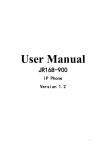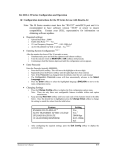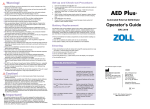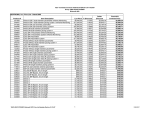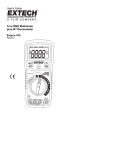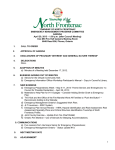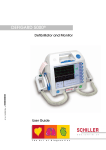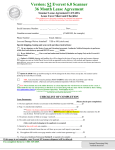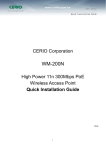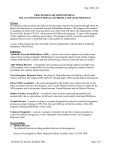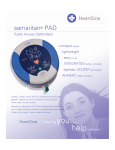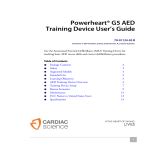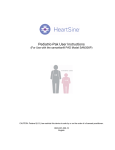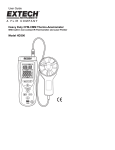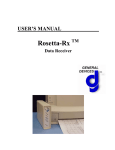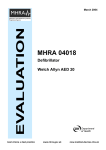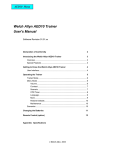Download SPECIAL POLICY: Automated External Defibrillators
Transcript
Francis Marion University SUBJECT: Automated External Defibrillator (AED) Program Revised 07/28/05 Policy Contact: Student Health Services or Campus Police INTRODUCTION The South Carolina Automated External Defibrillator Act, listed in SC Code of Laws Title 44 Chapter 76 (Attachment #1) permits a business, organization, association, etc., that meets certain requirements, to set up a program whereby someone suffering a cardiac arrest can receive treatment with an automated external defibrillator (AED) on-site by appropriately trained non-medical personnel before the arrival of emergency medical services (EMS) personnel. Because the AED is an advanced medical device that should be used only in an emergency by persons trained in the proper use of the device, specific requirements have been developed for authorized facilities that wish to set up an AED program. These requirements include training of AED operators by an approved AED training program, oversight of the authorized facility AED program by an AED liaison and, most critically, the ability to access 9-1-1 immediately. PURPOSE To establish a procedure identifying when properly trained members of the campus community may use a university Automated External Defibrillator (AED) in response to a cardiac arrest incident. DEFINITONS: • Automated External Defibrillator (AED): A medical device heart monitor and defibrillator that has received approval of its pre-market notification filed pursuant to the United States Code, Title 21, Section 360(k), from the United States Food and Drug Administration; is capable of recognizing the presence or absence of ventricular fibrillation or rapid ventricular tachycardia and is capable of determining, without intervention by an operator, whether defibrillation should be performed; and upon determining that defibrillation should be performed, automatically charges and requests delivery of an electrical impulse to an individual's heart. • Health Care Professional: A licensed physician, surgeon, physician's assistant, nurse practitioner, or nurse. • Designated AED User: A person identified by the person or entity acquiring an AED who has received training in the use of an AED pursuant to SC Code of Laws, Title 44, chapter 76. WARNINGS The following general warnings and safety considerations are for administrators, rescuers, and patients. • Only properly trained individuals should use the AED unit as described in the device user’s manual. Improper use of the device can cause death or injury. • • • • • • • • Always stand clear of the patient when delivering treatment. Defibrillation energy delivered to the patient may be conducted through the patient’s body and cause a lethal shock to those touching the patient. Dry patient’s chest, if wet, before attaching electrodes. Apply freshly opened and undamaged electrodes, within the electrode expiration date, to clean and dry skin to minimize burning. Move the patient away from electrically conductive surfaces prior to use of AED equipment. Do not touch the electrode surfaces, the patient, or any conductive material touching the patient during ECG analysis or defibrillation. Do not use an AED unit near or within puddles of water. Do not use an AED unit near flammable agents, such as gasoline, oxygen-rich atmospheres or flammable anesthetics. Keep the patient as motionless as possible during ECG analysis. AED LIAISON The Coordinator of Student Health Services/Family Nurse Practitioner acts as our community AED Liaison. The AED Liaison is responsible for approving the AED protocols or guidelines which includes CPR and AED training, AED deployment strategies, and an AED equipment maintenance plan. The liaison will receive maintenance and testing log information and copies of any paperwork detailing clinical use of any FMU AED unit. • • If the AED use involves an employee Human Resource will get an info copy of the use report. If the AED use involves a student then Student Affairs will get a copy. DESIGNATED AED USERS At Francis Marion University, designated AED users include campus police officers, trained athletics department staff and other campus community members appropriately trained in CPR and AED under American Heart Association, American Red Cross, or National Safety Council standards. When an AED is used to defibrillate a heart attack victim, the involved party shall complete a report by the end of the duty day to be forwarded to the appropriate individuals. AED LOCATIONS The ZOLL AED-PLUS Defibrillator being used on campus is located in listed buildings to ensure that they are available for immediate use throughout the campus. AED units are located in alarmed cabinets at the following locations: • • • • • • • Smith University Center by the Information Desk in the south end of the building. LSF/McNair on the south side by the vending machines CEMC in the south end of the building near the elevators (near the fire extinguisher cabinet) Founders Hall near Room 155 Stokes Administration Building in the hallway by the Registrar’s Office. Fine Art’s Center in the theater lobby Alston Housing Office hallway near copier POLICY Cardiac arrest occurs when the heart's electrical system causes the heart to quiver erratically; also known as ventricular fibrillation, preventing the pumping of blood throughout the body and brain. Death occurs within minutes unless the normal rhythm of the heart is restored. For each minute the heart is in fibrillation about 10 percent of the ability to restart the heart is lost. It is anticipated that the placement of an AED device in certain locations throughout campus may provide opportunities for trained community members to deliver a defibrillating shock to victims of cardiac arrest prior to the arrival of Campus Police First Responders or Emergency Medical Services. • A person who renders emergency care or treatment to a person in cardiac arrest caused by ventricular fibrillation/tachycardia by using an AED must activate the emergency medical services system or 911 as soon as possible. The user must also report any clinical use of the AED to the AED liaison. Use an AED device only when a suspected cardiac arrest victim has an apparent lack of circulation as indicated by: • Unconsciousness and • Absence of normal breathing and • Absence of a pulse or signs of circulation. Do not use an AED device when the patient is conscious or breathing or has a detectable pulse or other signs of circulation. This policy is a guideline for determining the appropriate level of response. It also provides guidelines for dispatching campus police officers to cardiac arrest or other medical situations where the use of an AED may be needed. In the continuing presence of a shockable ECG rhythm the ZOLL AED used on campus is designed to perform up to three ECG analyses and stacked shocks before it prompts the rescuer to initiate CPR. The AED device is intended to be used by personnel who are qualified by training in the use of the device through acceptable CPR/AED training. Users must have current training in CPR and AED use by the American Heart Association, American Red Cross, or National Safety Council. Automated External Defibrillators shall only be used in a manner specified by the manufacturer and only by personnel trained to properly operate the device. The Campus Police Department shall attempt to respond to all reported incidents of cardiac arrest within the campus boundaries. A cardiac arrest will be dispatched as an emergency in progress. Our ability to have an officer on scene ahead of EMS units shall be the main objective in responding to cardiac arrest. Emergency Medical Services will be contacted and notified after dispatching Campus Police Officers. Campus Police will notify the AED Liaison for all cardiac arrest incidents in addition to other specified notifications. Campus police officers will conduct monthly inspections of each AED unit. All AED equipment will be maintained and tested according to the manufacturer's operational guidelines and written records of maintenance and testing will be maintained. Any person or entity acting in good faith and gratuitously shall be immune from civil liability for the application of an AED unless the person was grossly negligent in the application. Any designated AED users meeting the requirements of Section 44-76-30(1) and acting according to the required training shall be immune from civil liability for the application of an AED unless the application was grossly negligent. A person or entity acquiring an AED and meeting the requirements of Section 44-76-30 or an AED liaison meeting the requirements of Section 44-7630 shall be immune from civil liability for the application of an AED by any person or entity described in items (1) or (2) of this section. A prescribing physician shall be immune from civil liability for authorizing the purchase of an AED, unless the authorization was grossly negligent. ZOLL AED-PLUS DEFIBRULATOR The ZOLL AED Plus is an automated external defibrillator (AED) that uses voice prompts and visual indicators to guide the rescuer through a resuscitation sequence that may include defibrillation and/or cardiopulmonary resuscitation (CPR). It is the unit that is currently in place at various campus facilities. The ZOLL AED Plus supports both adult and pediatric defibrillation electrode pads, and automatically adjusts the defibrillation energy based on the type of electrode pads connected to it. Following attachment of electrodes to a patient’s chest, the defibrillator monitors the electrocardiographic (ECG) rhythm of the patient’s heart, analyzes that rhythm, and determines whether the rhythm is shockable or non-shockable. When needed, defibrillation energy is delivered through these same electrodes. When the unit detects a shockable rhythm, it charges and issues the warning “Don’t touch patient, press treatment button”. The rescuer presses the Treatment/Shock Button to deliver the shock. If the patient remains in a shockable condition, additional shocks can be administered after subsequent analyses of the patient’s heart rhythm. The rescuer may be prompted to perform CPR if the initial or subsequent defibrillation attempts are unsuccessful. The AED Device is intended to be used by personnel who are qualified by training in the use of the device through acceptable CPR/AED training. In the continuing presence of a shockable ECG rhythm the ZOLL AED used on campus is designed to perform up to three ECG analyses and stacked shocks before it prompts the rescuer to initiate CPR. To prepare the suspected cardiac arrest victim after you have determined an apparent lack of circulation as indicated by the patient being unconscious, not breathing normally, having an absence of a pulse or signs of circulation: 1. Remove all clothing covering the patient’s chest. 2. Ensure the patients chest is dry 3. If the patient has excessive chest hair, clip or shave the hair to help ensure proper adhesion of the electrodes. To apply the CPR-D electrode pads to the suspected cardiac arrest victim: 1. Tear open the electrode package and unfold the electrodes. Place the electrodes on the patient according to the graphics on the package. 2. Hold the CPR sensor and place the sensor between the nipples and on the middle of the patient’s breastbone, using the sensor’s cross hairs to guide you. 3. Press the CPR sensor with your right hand and pull the number 2 tab to peel the protective backing from the electrode. Press the electrode from the center out to make sure it adheres properly to the patient’s skin. 4. Press the CPR sensor with your left hand and pull the number 3 tab to peel the protective backing from the electrode. Press the electrode from the center out to make sure it adheres properly to the patient’s skin. NOTE: If the patient is large or there is a need to place the electrode under the breast, you may need to tear away the lower pad at the perforated line and extend the pad. Place the pad slightly to the patient’s left and below the patient’s left breast. NOTE: If the patient has an implanted pacemaker or defibrillator in the upper right chest, angle the electrodes slightly to avoid placing the electrodes over either device. Make sure that the CPR sensor maintains a position over the lower half of the breastbone. CPR MONITORING FUNCTION: When used with ZOLL CPR-D padz, the ZOLL AED Plus monitors the rate and depth of CPR chest compressions. The ZOLL AED Plus provides a CPR metronome function designed to encourage rescuers to perform chest compressions at the AHA/ERC recommended rate of 100 compressions per minute. Voice and visual prompts encourage a compression depth of 1 ½ - 2 inches for adult patients. The CPR monitoring function operates only when CPR-D padz are used, and is intended for use on adult patients only. To use the ZOLL AED Plus CPR monitoring function you must do the following: 1 Connect CPR-D padz to the ZOLL AED Plus unit. 2 Apply the CPR-D padz to the patient as described in the previous section. Ensure that the CPR sensor is centered on the lower half of the patient’s sternum. 3 If no signs of circulation are present when the ZOLL AED Plus issues the IF NO CIRCULATION, START CPR prompt, place your hands on top of the CPR sensor and push on the sensor to deliver chest compressions to the patient. After your first few compressions, the ZOLL AED Plus metronome will begin issuing timing beeps. Try to maintain synchronization between these beeps and your chest compressions. Shortly after you stop chest compressions to deliver rescue breaths the metronome will stop beeping. NOTE If the ZOLL AED Plus prompts you to PUSH HARDER, your compressions are less than 1½ inches deep. Increase your compression depth to improve CPR performance. 4. Deliver the appropriate number of rescue breaths then resume chest compressions. The metronome will begin to beep again after your first few compressions have been delivered. PASSIVE AIRWAY SUPORT SYSTEM (PASS) If there is no evidence of head or neck trauma, the head tilt chin lift method is the recommended maneuver for opening the airway. The PASS may be placed under the patient’s shoulders to help maintain head tilt. WARNING! Do not use Passive Airway Support System (PASS) if you suspect a head or neck injury. Place the patient on a firm surface before performing CPR. If the patient requires airway support and there is no evidence of head or neck trauma, roll the patient on his/her side and then roll him/her back over so that the PASS is under the patient’s shoulders causing the head to tilt backwards. The shape of the PASS cover, when placed under the shoulders of the patient, can be used to help maintain an open airway. LIFEPAK CR-PLUS DEFIBRILLATOR This is the unit donated to the university and is currently used by Campus Police Officers. 1. If not treated cardiac arrest will cause death. In a cardiac arrest situation immediately call for help and activate the emergency response system. 2. Establish the patient is in cardiac arrest by using your CPR training. Position the LifePak CR-Plus near the patient and press the “lid release/on-off button to open the lid and turn the unit on. The voice prompts will begin and guide you through the response steps. 3. Expose the patient’s chest. If excessively hairy use the included razor to shave the hair. If the chest is dirty or wet wipe it clean and dry. You want to ensure the electrodes make good contact. 4. Hold down the left side of the electrode packet with one hand and pull the red packet handle with the other to open the package. 5. Remove the pads one at a time from the blue plastic and attach them to the exposed chest as indicated. 6. Listen to the voice prompt and don’t touch the patient until instructed to do so. Make sure no one else is touching the patient before the system provides the shock. 7. If the patient starts to move or breathe, leave the pads in place and ensure they remain connected to the unit. Place the patient in the recovery position, if possible and feasible and maintain care until arrival of advance EMS units. 8. Once EMS arrives advise them of the action you have taken, how long the patient was unconscious, if you delivered shocks, the number of shocks delivered and if you provided CPR. The unit makes a record of heart rhythms and shocks that can be transferred to a computer at a later time. The pads used may be compatible with EMS larger unit. 9. After using the unit, if the unit is turned on press and hold the lid release/on-off button for about 2 seconds to turn it off. Clean the unit and its accessories. Transfer the data if required. Replace the charge-pak and electrodes. Close the lid and verify the “OK” symbol appears in the readiness display. Dispose of the pads and other items appropriately. Attachment 1 Title 44 - Health CHAPTER 76 AUTOMATED EXTERNAL DEFIBRILLATORS SECTION 44-76-10. Short title. This act may be cited as the "South Carolina Automated External Defibrillator Act". SECTION 44-76-20. Definitions. For purposes of this chapter: (1) "Automated external defibrillator" or "AED" means an automated external defibrillator which is a medical device heart monitor and defibrillator that: (a) has received approval of its pre-market notification filed pursuant to the United States Code, Title 21, Section 360(k), from the United States Food and Drug Administration; (b) is capable of recognizing the presence or absence of ventricular fibrillation or rapid ventricular tachycardia and is capable of determining, without intervention by an operator, whether defibrillation should be performed; and (c) upon determining that defibrillation should be performed, automatically charges and requests delivery of an electrical impulse to an individual's heart. (2) "Health care professional" means a licensed physician, surgeon, physician's assistant, nurse practitioner, or nurse. (3) "Designated AED user" means a person identified by the person or entity acquiring an AED who has received training in the use of an AED pursuant to this chapter. SECTION 44-76-30. Training, maintenance, testing, use and reporting requirements for automated external defibrillators. (A) A person or entity that acquires an AED shall: (1) require its designated AED users to have current training in CPR and AED use by the American Heart Association, American Red Cross, or National Safety Council; (2) maintain and test the AED according to the manufacturer's operational guidelines and keep written records of maintenance and testing; (3) employ or obtain a health care professional to serve as its AED liaison; (4) have in place an AED program approved by its AED liaison which includes CPR and AED training, AED protocol or guidelines, AED deployment strategies, and an AED equipment maintenance plan; (5) include in its AED protocol or guidelines that a person who renders emergency care or treatment to a person in cardiac arrest caused by ventricular fibrillation/tachycardia by using an AED must activate the emergency medical services system or 911 as soon as possible; (6) report any clinical use of the AED to the AED liaison. SECTION 44-76-40. Immunity from civil liability for use of AED in compliance with requirements. (1) Any person or entity acting in good faith and gratuitously shall be immune from civil liability for the application of an AED unless the person was grossly negligent in the application. (2) Any designated AED users meeting the requirements of Section 44-76-30(1) and acting according to the required training shall be immune from civil liability for the application of an AED unless the application was grossly negligent. (3) A person or entity acquiring an AED and meeting the requirements of Section 44-76-30 or an AED liaison meeting the requirements of Section 44-76-30 shall be immune from civil liability for the application of an AED by any person or entity described in items (1) or (2) of this section. (4) A prescribing physician shall be immune from civil liability for authorizing the purchase of an AED, unless the authorization was grossly negligent. SECTION 44-76-50. Applicability of chapter. The provisions of this chapter do not apply to emergency medical services, a physician's office, or a health care facility as defined in Section 44-7-130(10).








